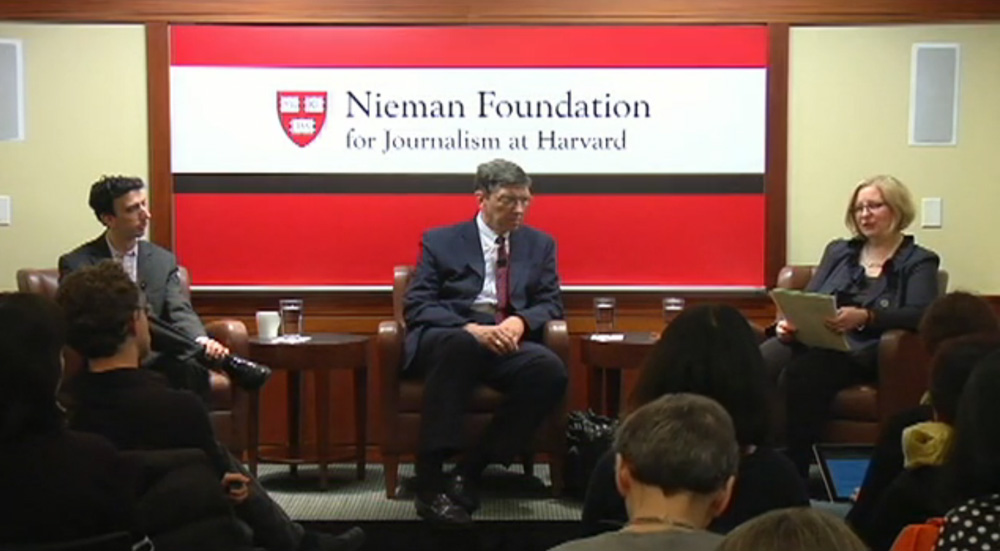The idea is broadly misunderstood, said Harvard professor Clayton Christensen. Disruptive innovation isn’t just about being new, different or radical.
Disruptive innovation is transforming “something that used to be complicated and expensive so that only the rich and people with a lot of skill had access to it and could use it” and making it “so much more affordable, simple and accessible that a whole new population of people has ready access to it.”
Christensen is the authority on disruptive innovation and wrote “The Innovator’s Dilemma,” a book that was said to have deeply influenced Steve Jobs, the epitome of a tech innovator.
Last year, Christensen, along with Nieman fellow David Skok and James Allworth collaborated on researching disruptive innovation in journalism. That paper became “Breaking News,” which you can download as an e-book.

David Skok, Clay Christensen and Nieman Foundation curator Ann Marie Lipinski during their discussion disruptive innovation and journalism. (Screengrab from NiemanLab website)
A few days ago, Christensen and Skok discussed innovation and its impact on journalism in an event hosted by the Nieman Foundation.
Whatever it is you are doing now, stop and watch the video (you can find it in the NiemanLab website) or listen to its audio in one of my favorite podcasts. Although they discussed disruptive innovation in relation to journalism, the principles are industry-agnostic.
The video starts with Christensen differentiating sustaining innovation from disruptive innovation. He said majority of innovations are sustaining innovations, which involves making products and services better. He said industry leaders are good when it comes to sustaining innovation but could hardly get disrupting innovations.
He said understanding the concepts will help predict who will win in a battle of innovation. If it’s disruptive, “entrants will win.” Christensen said this is happening in journalism.
Skok said that in looking at the future, one should set aside profit statements as these are generally “snapshots of the past.” He said Christensen’s work tells you to “trust the theory” and not the balance sheet.
Companies shouldn’t be complacent when their balance sheets say they are still doing well because “it’s hard to see the cliff.” Christensen cited the case of Digital Equipment Corp., which went down the cliff in 1988, two years after hitting its peak in profitability.
“And a company that took three decades to build was gone in two years because you don’t see it,” he said.
Christensen also talked about another of his key frameworks: looking at things from the point of view of “jobs to be done.” He said understanding the customer is the “wrong unit of analysis,” what is important is understanding the job that needs to be done.
“I have all kinds of characteristics. But none of these characteristics or attributes have yet caused me to go out and buy the New York Times today,” he said. “There might be a correlation between particular characteristics and the propensity that I will buy the New York Times but they don’t cause me to buy it.”
“What causes us to buy something or hire it or rent it is stuff happens to us, all day. Jobs arise in our lives that we need to get done and we hire products or buy products and pull them in our lives to get the job done.”
He said it is important that people understand the job that needs to be done because it is very stable over time.
“If you keep focusing on the job, you weather ebbs and flows of technology as they come into your industry.”
Christensen said Apple, which had become an afterthought in the history of computing, became the company that it is because Steve Jobs “developed a sequence of products focused on the job to be done.”
He said the news industry still has ways “to create the next generation of distribution channel for your efforts. But you have to organize it around jobs to be done where you’ve got better ability to nail the job than your competitors.”
Skok said that “if you can see the disruption of your own business, chances are somebody else out there can see it too. And so you’re better off disrupting yourself.”
He said that Christensen’s research “is very clear on this. You have to incubate it outside of existing processes.”
He also said that in their operations, they are “patient for growth but impatient for profits.” He said they always try to maintain a margin of revenue neutral or profitability.
Skok said that if there’s something disruptive right now, it’s mobile. “The jobs that can be done better through mobile are immense,” he said.
The post Disruptive innovation and journalism appeared first on Leon Kilat : The Tech Experiments.